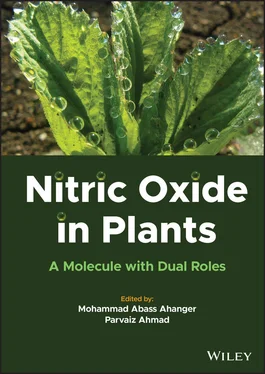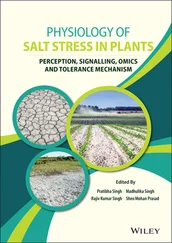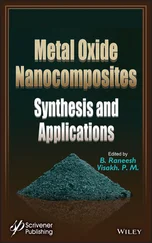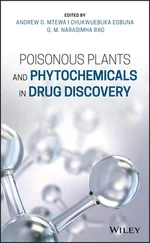Nitric Oxide in Plants
Здесь есть возможность читать онлайн «Nitric Oxide in Plants» — ознакомительный отрывок электронной книги совершенно бесплатно, а после прочтения отрывка купить полную версию. В некоторых случаях можно слушать аудио, скачать через торрент в формате fb2 и присутствует краткое содержание. Жанр: unrecognised, на английском языке. Описание произведения, (предисловие) а так же отзывы посетителей доступны на портале библиотеки ЛибКат.
- Название:Nitric Oxide in Plants
- Автор:
- Жанр:
- Год:неизвестен
- ISBN:нет данных
- Рейтинг книги:5 / 5. Голосов: 1
-
Избранное:Добавить в избранное
- Отзывы:
-
Ваша оценка:
- 100
- 1
- 2
- 3
- 4
- 5
Nitric Oxide in Plants: краткое содержание, описание и аннотация
Предлагаем к чтению аннотацию, описание, краткое содержание или предисловие (зависит от того, что написал сам автор книги «Nitric Oxide in Plants»). Если вы не нашли необходимую информацию о книге — напишите в комментариях, мы постараемся отыскать её.
Examines the beneficial roles of nitric oxide in growth and stress tolerance regulation through its involvement in tolerance mechanisms Nitric Oxide in Plants: A Molecule with Dual Roles
Nitric Oxide in Plants: A Molecule with Dual Roles
Nitric Oxide in Plants — читать онлайн ознакомительный отрывок
Ниже представлен текст книги, разбитый по страницам. Система сохранения места последней прочитанной страницы, позволяет с удобством читать онлайн бесплатно книгу «Nitric Oxide in Plants», без необходимости каждый раз заново искать на чём Вы остановились. Поставьте закладку, и сможете в любой момент перейти на страницу, на которой закончили чтение.
Интервал:
Закладка:
Yachana JhaN.V. Patel College of Pure and Applied Sciences CVM University Vallabh Vidyanagar Nagar Anand Gujarat India
Snehashis KarmakarDepartment of Plant Physiology Faculty of Agriculture Bidhan Chandra Krishi Viswavidyalaya Mohanpur Nadia West Bengal India
Harsimran KaurPlant Protection Division PG Department of Agriculture Khalsa College Amritsar Punjab India
Mushtaq Ahmad KhahDepartment of Botany Shri JJT University Jhunjhunu Rajasthan India
Sukhmeen Kaur KohliPlant Protection Division PG Department of Agriculture Khalsa College Amritsar Punjab India
Plant Stress Physiology Lab
Department of Botanical and
Environment Sciences
Guru Nanak Dev University
Amritsar
Punjab
India
Asha KumariICAR-Vivekananda Parvatiya Krishi Anusandhan Sansthan Almora Uttarakhand India
Saima LiaqatDepartment of Botany School of Chemical and Life Sciences Jamia Hamdard New Delhi India
Rayees Ahmad MirSchool of Studies in Botany Jiwaji University Gwalior India
Anupam MondalLaboratory of Microbial Interaction School of Biotechnology Presidency University Kolkata West Bengal India
Sananda MondalDepartment of Crop Physiology Institute of Agriculture Visva-Bharati Sriniketan Birbhum West Bengal India
Anna Rita PaolacciDipartimento per la Innovazione nei Sistemi Biologici Agroalimentari e Forestali Università della Tuscia Viterbo Italy
Stefania PasqualiniDipartimento di Chimica Biologia e Biotecnologie Università di Perugia Perugia Italy
Fozia SardarNational Institute for Biotechnology and Genetic Engineering – Campus Pakistan Institute of Engineering and Applied Sciences (NIBGE-C-PIEAS) Faisalabad Pakistan
Iffat ShaheenCollege of Agriculture Bahauddin Zakariya University Multan Pakistan
Binny SharmaDepartment of Plant Physiology Institute of Agricultural Sciences Banaras Hindu University Varanasi Uttar Pradesh India
Amar Pal SinghNational Institute of Plant Genome Research Aruna Asaf Ali Marg New Delhi India
Bansh Narayan SinghDepartment of Plant Physiology Institute of Agricultural Sciences Banaras Hindu University Varanasi Uttar Pradesh India
Agostino SorgonàDipartimento di Agraria Università Mediterranea di Reggio Calabria Loc. Feo di Vito Reggio Calabria Italy
Muhammad WaseemHorticulture South China Agricultural University Guangzhou China
Rinukshi WimalasekeraDepartment of Botany Faculty of Applied Sciences University of Sri Jayewardenepura Gangodawila Nugegoda Sri Lanka
Mobina UlfatDepartment of Botany Lahore College for Women University Lahore Pakistan
Zafar Ullah ZafarInstitute of Pure and Applied Biology Bhauddin Zakria University Multan Pakistan
1 Nitric Oxide: A Dynamic Signaling Molecule Under Plant Stress
Asha Kumari1, Binny Sharma2, Bansh Narayan Singh2, and Padmanabh Dwivedi2
1ICAR-Vivekananda Parvatiya Krishi Anusandhan Sansthan, Almora, Uttarakhand, India
2Department of Plant Physiology, Institute of Agricultural Sciences, Banaras Hindu University, Varanasi, Uttar Pradesh, India
1.1 Introduction
Nitrogen monoxide, often known as nitric oxide, is a physiologically active chemical that is widely used in animal and plant signaling mechanisms. In plants and animals, it is an intracellular and intercellular signaling molecule with a variety of regulatory roles. Its functions in the central nervous, cardiovascular, and immunological systems, platelet inhibition, programmed cell death, and host responses to infection, among other things, have been widely studied in animals.
Because of the presence of an unpaired electron, it is a highly reactive gaseous molecule that occurs with oxygen in a variety of reduced states such as nitroxyl ion (NO −), nitric oxide free radical (NO •), and nitrosonium (NO +). These NO-derived molecules are referred to as reactive nitrogen species (RNS). NO influences signaling in biological systems through a variety of mechanisms. The interaction of NO •with O 2results in the formation of several redox compounds (including NO 2 •, N 2O 3, and N 2O 4), which may react with cellular amines and thiols or simply change to form the metabolites nitrogen dioxide radical (NO 2 −) and nitrate (NO 3 −) (Wendehenne et al. 2001). NO combines with dioxygen to form NO 2or with reactive oxygen species (ROS) to form peroxynitrite (ONOO −), which triggers cellular damage. NO •facilitates electrophilic assault on reactive sulfur, oxygen, nitrogen, and aromatic carbon centers, with thiols being the most reactive of the reactive teams. Nitrosation is the name given to this natural process. Nitrosation of numerous enzymes or proteins results in chemical change, which may affect the function of those entities. These alterations are reversible, and supermolecule nitrosation–denitrosation might be a crucial mechanism for controlling signal transduction (Hayat et al. 2010).
In contrast to the mammalian system, the cellular/subcellular localization of NO production in plants is exceedingly diverse and contentious. The production of NO in plants is determined by the plant’s physiological condition. This includes NO production during root development, stomatal movement control, blooming, plant component expansion, and leaf senescence (Neill et al. 2002; Mishina et al. 2007). NO is produced in plants through nonenzymatic and accelerator systems, depending on the plant species, organ, or tissue, as well as the plant’s state and ever-changing environmental circumstances. The most effective recognized NO sources in plants are as a substrate by cytosolic (cNR) and membrane-specific nitrate enzyme (PM-NR), and NO synthesis by many arginine-dependent gas synthase-like activities (NOS).
According to studies, mitochondria are a major source of arginine- and nitrite-dependent NO synthesis in plants. Tischner et al. acquired the first evidence for mitochondrial NO synthesis in plants when they assessed NO production under anoxic conditions from the unicellular blue green alga Chlorella sorokiniana (Tischner et al. 2004). This green alga does not create NO when exposed to nitrate (NO 3), but it does create NO when exposed to nitrite (NO 2). NO generation was also inhibited by mitochondrial electron transport inhibitors. Shortly after, mitochondrial NO synthesis in higher plants was discovered. Gupta et al. discovered mitochondrial NO production in barley plants grown in anoxic conditions (Gupta and Kaiser 2010). Under anoxic circumstances, a tobacco Nia 1, 2 (nitrate reductase-deficient) cell suspension was able to manufacture NO from exogenous nitrite, despite the absence of nitrate reductase (which can also manufacture NO from nitrite) (Gupta et al. 2011). Other putative NO producers in plants include xanthine oxido-reductase, peroxidase, and cytochrome P450. NO is a ubiquitous chemical that is found in all eukaryotes. The NR system is by far the most effective and well-characterized mechanism for NO generation in plants. In this case, the cytosolic NR mostly catalyzes the reduction of nitrate to NADH as the predominant negatron donor. NR’s NAD(P)H-dependent NO production has been demonstrated in vitro and in vivo (Rockel et al. 2002). The biological significance of NR activity as a source of NO was first shown in Arabidopsis guard cells by Desikan et al. (2002). The peroxisomal catalyst organic compound enzyme can also catalyze group reduction to NO (XOR). XOR activity in pea ( Pisum sativum ) leaves is linked to peroxisomes, and as a result, the possibility of interaction between the construction of reactive chemical elements and reactive gas species (ROS and RNS, respectively) has been suggested (del Río et al. 2004). NO production in animals was demonstrated by a chemical reaction of arginine transforming into citrulline mediated by the enzyme NO synthase (Palmer et al. 1987). Following the discovery of a purpose for NO in plants in 1998 (Delledonne et al. 1998; Durner et al. 1998), several researchers began to look for NOS activity in plants, despite the fact that the Arabidopsis thaliana ordering failed to reveal any factor with significant similarity to animal NOS (Moreau et al. 2010).
Читать дальшеИнтервал:
Закладка:
Похожие книги на «Nitric Oxide in Plants»
Представляем Вашему вниманию похожие книги на «Nitric Oxide in Plants» списком для выбора. Мы отобрали схожую по названию и смыслу литературу в надежде предоставить читателям больше вариантов отыскать новые, интересные, ещё непрочитанные произведения.
Обсуждение, отзывы о книге «Nitric Oxide in Plants» и просто собственные мнения читателей. Оставьте ваши комментарии, напишите, что Вы думаете о произведении, его смысле или главных героях. Укажите что конкретно понравилось, а что нет, и почему Вы так считаете.












